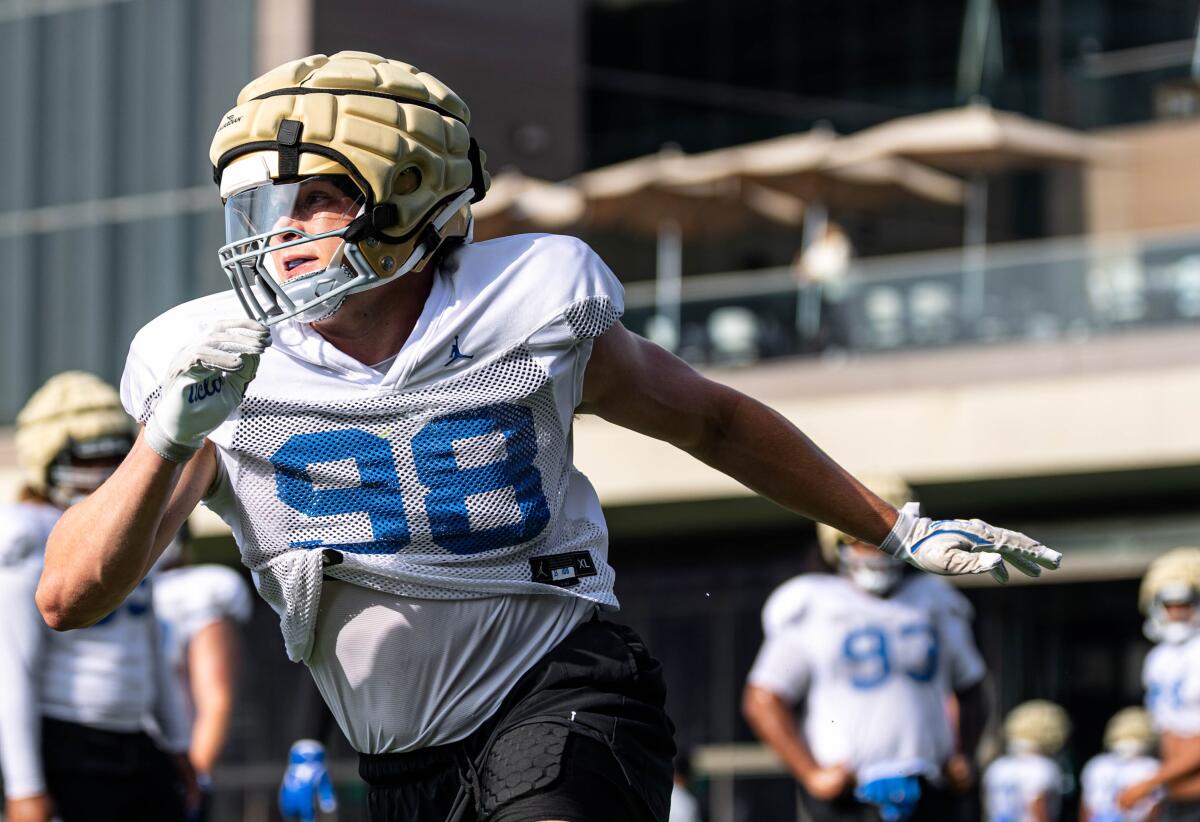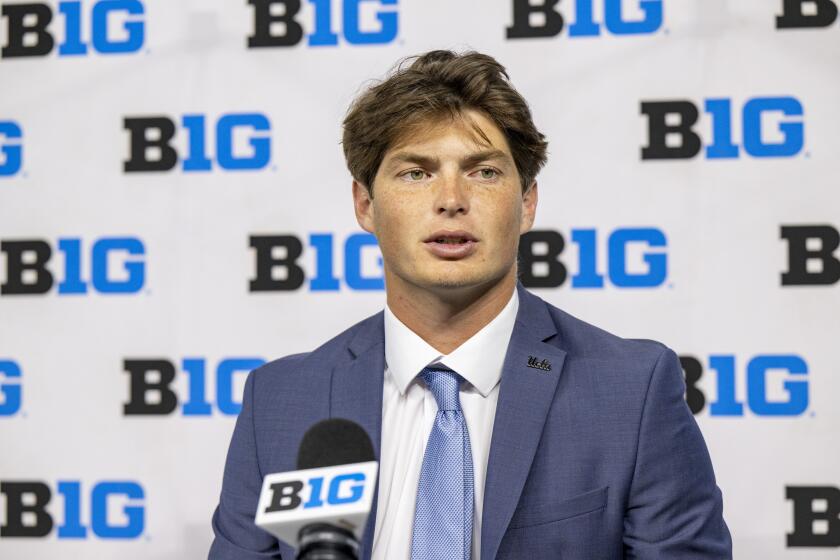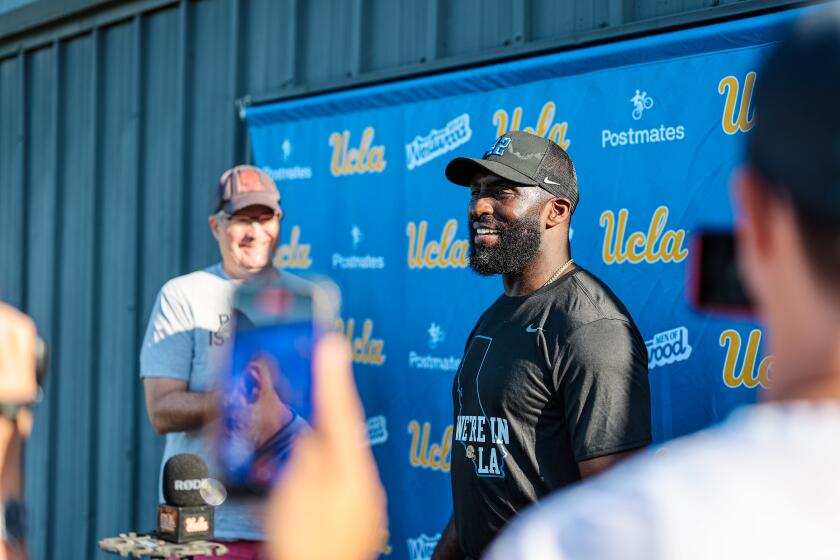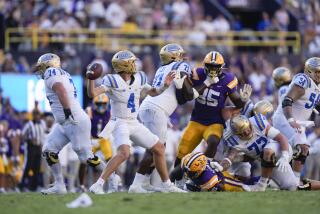From NCAA Division III to the Big Ten: The unlikely rise of UCLA’s Luke Schuermann

Luke Schuermann often gets “the look” whenever he mentions his last football stop. It can be a quizzical expression or a blank stare based on the level of knowledge of the words just spoken.
Johns Hopkins? Wait, give me a second. Oh, you mean the school known for producing renowned journalists, doctors and scientists?
That’s right. That one. Among its most famous alumni are CNN anchor Wolf Blitzer, former President Woodrow Wilson and film director Wes Craven.
Something the Baltimore-based private research institution is not known for is its football program. Its first team, in 1882, had to play as the Clifton Athletic Club because of the school’s contempt for the emerging sport. For its first 13 seasons, students served as coaches.
More than a century later, the Blue Jays are still playing in the shadows. They’re a plucky NCAA Division III operation that averages a few thousand fans for home games, its players doubling as promoters.
“I’ve had people be like, ‘Oh, I didn’t know they had a football team, you know, I just thought they had like a med school,’ ” Schuermann said with a chuckle.
Even as a three-time All-American, Schuermann never became a household name outside his own abode. Maybe that’s why UCLA is the transfer edge rusher’s new football home, the next stop on an improbable journey that Schuermann hopes can take him from Division III to the Big Ten to the NFL.
“He’s not like, if it happens, it happens,” said Jennifer Schuermann, Luke’s mother. “He’s going to do everything he can to try to make it happen.”
The NFL is already well-versed in this underdog story, every team having sent a scout to watch Luke play or practice while at Johns Hopkins, according to Dan Wodicka, the Blue Jays coach who was the defensive line coach and defensive coordinator when Luke played there.
Those scouts saw an edge rusher who more than looked the part at a stout 6-foot-4 and 255 pounds. He was faster than most of the team’s skill players in conditioning drills and a blur in the backfield, finishing his career as Johns Hopkins’ all-time leaders in tackles for loss (62.5) and sacks (34.5) despite playing only three seasons.
Ethan Garbers’ development and TJ Harden’s success are among the top takeaways from UCLA’s preseason football practice open to the public.
Like every quality edge rusher, Schuermann has a signature move — his involving the Gumby-like ability to bend his shoulder so that he can elude the offensive tackle on his way to the quarterback.
What makes Wodicka believe that Schuermann can thrive at a much higher level are the smarts and drive that helped him attain a 3.69 grade-point average as a mechanical engineering major while becoming a finalist for the Campbell Trophy — known as the “Academic Heisman” — that was awarded to Oregon’s Bo Nix.
Somehow, Schuermann also found time to serve as a de facto assistant coach.
“He’s the best I’ve ever coached in terms of the preparation he puts in,” Wodicka said. “He would be sending me game-planning notes late at night on a Tuesday as he’s seeing tendencies” of the other team.
Now he’s prepping to go after Big Ten quarterbacks following an assist from another Johns Hopkins success story. Chip Kelly, whose first full-time coaching job came as Johns Hopkins’ defensive coordinator in 1993, always kept tabs on his old team even as he rose to become a major college and NFL coach.
Schuermann’s big showing on the small stage caught Kelly’s interest and earned him a recruiting visit to UCLA, where coaches praised his relentlessness and told him and his father that he could help mentor younger players based on his own constant improvement.
Coach DeShaun Foster and his new staff kept the commitment to Schuermann even after Kelly departed to become Ohio State’s offensive coordinator, believing that the redshirt senior’s size and speed (he’s been clocked at 21.23 miles per hour at a dead sprint) could allow him to contribute for a team needing to replace its entire fleet of edge rushers.
UCLA athletic director Martin Jarmond says he’s confident the Bruins are well-prepared for every aspect of their move to the Big Ten.
“We got some size guys for defensive ends, we got some quick guys, and then I need a motor guy,” UCLA defensive coordinator Ikaika Malloe said, referring to Schuermann with his last description. “So, as long as we can teach him the technique and he can unlearn some things because our [style of pass rush] is a little bit unorthodox, I think he’ll be a great addition.”
After one early preseason camp practice, Malloe commended Schuermann in front of the entire defense for his effort in sprinting to the other end of the field as part of a post-play conditioning drill that others sometimes completed with a half-hearted jog.
There remains a lot of ground to cover given that Schuermann was competing with the third string during a practice open to reporters last week. Acknowledging that the early transition has been “a little intimidating,” Schuermann said the challenge could fuel his growth.
“I’ve had good days and bad days,” he said, “but I’m trying not to focus too much on right now, at least, how well I’m doing and focus more on what can I improve on every single day.”
Those closest to Schuermann say he’s never been one to concede defeat. A straight-A student his whole life, Schuermann was frantic in middle school when a teacher gave him a C as part of a summer writing assignment.
“He worked on that like half the night to get the paper right,” Jennifer Schuermann said of revision efforts that proved worthwhile. By summer’s end, Luke won the award for most dedicated student.
The UCLA football team is staying in a Woodland Hills hotel during preseason camp. Coach DeShaun Foster said the goal is to promote team bonding.
He’s already risen from humble football beginnings. As a high school prospect from St. Louis, he was recruited mostly by Football Championship Subdivision schools and Iowa, which offered him a spot as a preferred walk-on. He chose Johns Hopkins because of its academic reputation and coaches who made him feel valued.
Similar thinking went into his decision to transfer to UCLA instead of accepting a spot as a walk-on at Missouri. Schuermann was drawn by the chance to complete a project management program through the extension school that will give him business savvy to complement his undergraduate degree.
There was also the opportunity to play for Malloe, who helped send a slew of players to the NFL when he coached at Washington before developing UCLA’s Laiatu Latu into a first-round pick last spring. If all goes well, Schuermann will join the list of 21 Division III players who have been drafted since 1990, even if his stopover in Westwood adds an asterisk.
Malloe recently asked Schuermann and the other defensive players to read the book “Chop Wood Carry Water,” which provides insight on the discipline it takes to accomplish something extraordinary. It might feel as if Schuermann is on the verge of writing his own epilogue.
“Everything that you’ve seen that he’s done in college at the D-III level,” Foster said, “he’s capable of doing here.”
More to Read
Go beyond the scoreboard
Get the latest on L.A.'s teams in the daily Sports Report newsletter.
You may occasionally receive promotional content from the Los Angeles Times.










